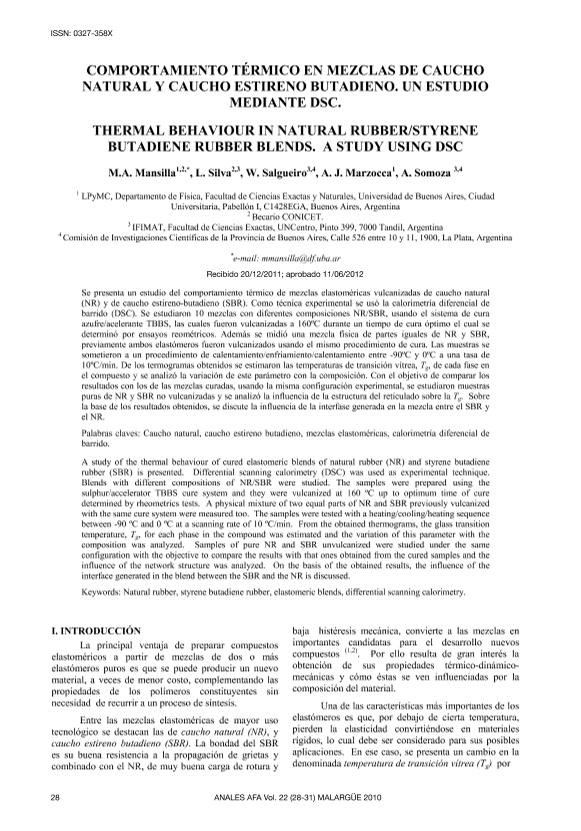Artículo
Se presenta un estudio del comportamiento térmico de mezclas elastoméricas vulcanizadas de caucho natural (NR) y de caucho estireno-butadieno (SBR). Como técnica experimental se usó la calorimetría diferencial de barrido (DSC). Se estudiaron 10 mezclas con diferentes composiciones NR/SBR, usando el sistema de cura azufre/acelerante TBBS, las cuales fueron vulcanizadas a 160ºC durante un tiempo de cura óptimo el cual se determinó por ensayos reométricos. Además se midió una mezcla física de partes iguales de NR y SBR, previamente ambos elastómeros fueron vulcanizados usando el mismo procedimiento de cura. Las muestras se sometieron a un procedimiento de calentamiento/enfriamiento/calentamiento entre -90ºC y 0ºC a una tasa de 10ºC/min. De los termogramas obtenidos se estimaron las temperaturas de transición vítrea, Tg, de cada fase en el compuesto y se analizó la variación de este parámetro con la composición. Con el objetivo de comparar los resultados con los de las mezclas curadas, usando la misma configuración experimental, se estudiaron muestras puras de NR y SBR no vulcanizadas y se analizó la influencia de la estructura del reticulado sobre la Tg. Sobre la base de los resultados obtenidos, se discute la influencia de la interfase generada en la mezcla entre el SBR y el NR. A study of the thermal behaviour of cured elastomeric blends of natural rubber (NR) and styrene butadiene rubber (SBR) is presented. Differential scanning calorimetry (DSC) was used as experimental technique. Blends with different compositions of NR/SBR were studied. The samples were prepared using the sulphur/accelerator TBBS cure system and they were vulcanized at 160 ºC up to optimum time of cure determined by rheometrics tests. A physical mixture of two equal parts of NR and SBR previously vulcanized with the same cure system were measured too. The samples were tested with a heating/cooling/heating sequence between -90 ºC and 0 ºC at a scanning rate of 10 ºC/min. From the obtained thermograms, the glass transition temperature, Tg, for each phase in the compound was estimated and the variation of this parameter with the composition was analyzed. Samples of pure NR and SBR unvulcanized were studied under the same configuration with the objective to compare the results with that ones obtained from the cured samples and the influence of the network structure was analyzed. On the basis of the obtained results, the influence of the interface generated in the blend between the SBR and the NR is discussed.
Comportamiento térmico en mezclas de caucho natural y caucho estireno butadieno: Un estudio mediante DSC
Título:
Thermal behaviour in natural rubber/styrene butadiene rubber blends: A study using DSC
Mansilla, Marcela Angela ; Silva, Leonel Ignacio
; Silva, Leonel Ignacio ; Salgueiro, Walter Alberto; Marzocca, Angel José; Somoza, Alberto Horacio
; Salgueiro, Walter Alberto; Marzocca, Angel José; Somoza, Alberto Horacio
 ; Silva, Leonel Ignacio
; Silva, Leonel Ignacio ; Salgueiro, Walter Alberto; Marzocca, Angel José; Somoza, Alberto Horacio
; Salgueiro, Walter Alberto; Marzocca, Angel José; Somoza, Alberto Horacio
Fecha de publicación:
28/10/2010
Editorial:
Asociación Física Argentina
Revista:
Anales AFA
ISSN:
0327-358X
e-ISSN:
1850-1168
Idioma:
Español
Tipo de recurso:
Artículo publicado
Clasificación temática:
Resumen
Archivos asociados
Licencia
Identificadores
Colecciones
Articulos(CIFICEN)
Articulos de CENTRO DE INV. EN FISICA E INGENIERIA DEL CENTRO DE LA PCIA. DE BS. AS.
Articulos de CENTRO DE INV. EN FISICA E INGENIERIA DEL CENTRO DE LA PCIA. DE BS. AS.
Citación
Mansilla, Marcela Angela; Silva, Leonel Ignacio; Salgueiro, Walter Alberto; Marzocca, Angel José; Somoza, Alberto Horacio; Comportamiento térmico en mezclas de caucho natural y caucho estireno butadieno: Un estudio mediante DSC; Asociación Física Argentina; Anales AFA; 22; 2; 28-10-2010; 28-31
Compartir
Altmétricas



